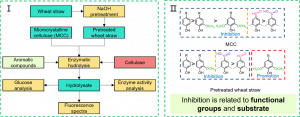Impact of Diverse Aromatic Compounds on Enzymatic Hydrolysis of Cellulose and Wheat Straw
The functional groups of aromatic compounds play vital roles on enzymatic hydrolysis
CHINA, February 8, 2024 /EINPresswire.com/ -- The intensive consumption of fossil fuels has an adverse effect on the environment. Therefore, using renewable biomass to replace produce chemicals of crude oil, materials and biofuels is important. However, there are still many problems of such technology, for example, the interference and influence of small molecule aromatic combination in the process of degradation and transformation. Fortunately, Yongcan Jin’s team have achieved significant results in this field.This team tests nine aromatic compounds as additives to understand their effect on the hydrolysis yield of microcrystalline cellulose (MCC) and alkaline pretreated wheat straw. Based on the results, the inhibition of aldehyde groups on MCC was greater than that of carboxyl groups, whereas for the alkaline pretreated wheat straw case, the inhibitory effect of aldehyde groups was lower than that of carboxyl groups. And increased methoxyl groups of aromatic compounds reduced the inhibitory effect on enzymatic hydrolysis of both substrates. It shows that stronger inhibition of aromatic compounds on MCC hydrolysis was detected in comparison with the alkaline pretreated wheat straw, and it indicates that the substrate lignin can offset the inhibition to a certain extent. Among all aromatic compounds, syringaldehyde with one aldehyde group and two methoxyl groups improved the glucan conversion of the alkaline pretreated wheat straw.
Yongcan Jin et al., the investigator who led the study, emphasizes that their extensive research into aromatic compounds on enzymatic hydrolysis in lignocellulose offers valuable guidance. Moreover, it is significant for mitigating the inhibitory effects of phenolic compounds in the enzymatic hydrolysis process, and ultimately enhancing cellulose enzymatic hydrolysis efficiency and reducing the production cost of bioethanol.
DOI
https://doi.org/10.1016/j.jobab.2023.12.006
Original Source URL
https://www.sciencedirect.com/science/article/pii/S2369969823000804
Emma Cao
Grayhole (Beijing) Technology Services Co., Ltd.
+8615510515110
email us here
Visit us on social media:
Facebook
Twitter
LinkedIn
Instagram
YouTube
Other
Legal Disclaimer:
EIN Presswire provides this news content "as is" without warranty of any kind. We do not accept any responsibility or liability for the accuracy, content, images, videos, licenses, completeness, legality, or reliability of the information contained in this article. If you have any complaints or copyright issues related to this article, kindly contact the author above.

